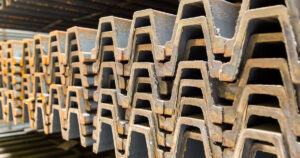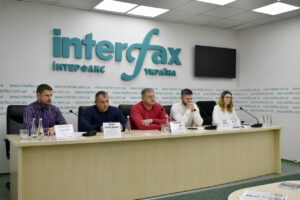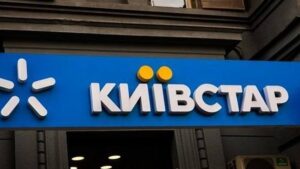
PrJSC Dniprovsky Metallurgical Plant (DMZ, formerly Evraz-DMZ), part of businessman Oleksandr Yaroslavsky’s DCH Steel group, increased its net loss by 3.1 times compared to the same period last year, to UAH 467.490 million from UAH 152.309 million, according to the results for January-September of this year.
According to the interim report, net income for the reporting period decreased by 64.6%, to UAH 1 billion 518.613 million from UAH 4 billion 289.634 million.
The uncovered loss at the end of September 2025 amounted to UAH -199.622 million.
Production volumes in Q3 2025 amounted to 0.6 thousand tons of metal products, in Q2 – 0.5 thousand tons of metal products and 20.3 thousand tons of coke, and in Q1 – 2.3 thousand tons of metal products and 54.9 thousand tons of coke.
Taking into account the current situation in Ukraine, the industry, and the restrictions in place, as well as the fact that the 2026 budget has not yet been formed, the projected volume of work and services is planned for the following areas of activity: services for processing tolling raw materials into rolled products – 70 thousand tons.
In addition to its core production activities, in Q3 2025, DMZ continued to expand its scope of activities and perform work for contractors in the manufacture and repair of metal structures and laboratory research.
In Q3, the average number of full-time employees was 699, and the wage fund was UAH 57.722 million. At the same time, the wage fund for the quarter decreased by UAH 32.950 million compared to Q2 2025, which was due to the lack of raw materials and a market for products, the shutdown of coke production in May 2025, and the corresponding reduction in personnel.
According to the annual report, in 2024, production volumes amounted to 289.1 thousand tons of blast furnace coke, metal products were not manufactured, but 44.6 thousand tons of square billets were rolled into finished rolled products under a tolling scheme. At the same time, there was a 1.2% decrease in blast furnace coke and a 57.1% decrease in rolled products. In terms of the structure of metal products in 2024, the share of rolled products from rolling mill (RM) No. 1 was 11.3%, and RM No. 2 was 88.7%. The rolling mills of DMZ produced channels, long products, mine props, and rails.
The average number of full-time employees in 2024 decreased by 12.6% to 1,707 people, and the FOP amounted to UAH 415.236 million. The average salary was UAH 19,442 (+17.4% from the 2023 level).
DMZ reported a net loss of UAH 222.117 million in 2024, compared to a net profit of UAH 504.591 million in 2023. Net income decreased by 20.8% to UAH 5 billion 412.422 million from UAH 6 billion 832.241 million.
Retained earnings at the end of 2024 amounted to UAH 170.605 million.
As reported, in 2024, DMZ reduced its rental services by 59.4% compared to 2023, to 42.9 thousand tons, and coke production decreased by 1.2%, to 289.1 thousand tons.
DMZ reduced its rolling services by 23.1% in the first seven months of 2025 compared to the same period last year, to 26,000 tons. in January-August 2025, the plant rolled 33.9 thousand tons, which is at the level of January-July 2024 (33.8 thousand tons).
According to information in the corporate newspaper DCH Steel, during the production campaign in rolling shop No. 2, which will begin after November 10, 2025, it is planned to manufacture (roll) 6.3 thousand tons of metal products.
DMZ received a net profit of UAH 4.225 million in 2022, while in 2021 it was UAH 1 billion 725.157 million. In 2021, the plant received a net profit of UAH 1 billion 725.157 million, while it ended 2020 with a net loss of UAH 394.091 million.
DMZ specializes in the production of steel, cast iron, rolled products, and products made from them.
On March 1, 2018, the DCH Group signed an agreement to purchase the Dnipro Metallurgical Plant from Evraz.
According to NDU data for the second quarter of 2025, Drampisco Limited (Cyprus) owns 97.73% of DMZ shares.
The authorized capital of the private joint-stock company is UAH 574.994 million, and the nominal value of a share is UAH 0.25.
Geographic structure of Ukraine’s foreign trade (trade volume) in January-May 2025, mln. Usd

Source: Open4Business.com.ua

Sales of new commercial vehicles (trucks and special-purpose vehicles) in Ukraine in October 2025 increased by 11% compared to the same month in 2024, reaching 1,203 units, which is also 8% more than in September 2025, according to UkrAvtoprom’s Telegram channel.
As in the previous year, Peugeot was the market leader in October with 115 units sold, compared to 246 units sold in October 2024.
Peugeot took second place with 121 cars. Last October, the brand was eighth in the ranking with 60 cars.
Citroen took third place in the ranking with 95 units, which is 16 cars less than in October 2024, when the brand was second in the ranking. MAN came in fourth with sales of 90 cars, which is 14 units more than in October last year.
Volvo also made it into the top five most popular new special-purpose vehicles with 84 units, which was 13th in October last year with sales of 17 vehicles.
According to UkrAvtoprom, a total of 9,853 new vehicles were added to the Ukrainian fleet of trucks and special-purpose vehicles in January-October, which is 5.5% less than in the same period last year.
As reported, in 2024, according to UkrAvtoprom, 12,900 new commercial vehicles were registered in Ukraine, which is 14% more than in 2023.

Škoda Group CEO Petr Novotny took part in a business roundtable in Brussels chaired by President of Uzbekistan Shavkat Mirziyoyev. The discussions focused on deepening cooperation in the field of modernization of transport infrastructure and introduction of European technologies.
At the meeting, Škoda Group presented its strategy for entering the Uzbek market through a joint venture that will focus on three areas:
According to Petr Novotny, Uzbekistan is a promising market open to European investment, and Škoda’s plans are in line with the objectives of the new Enhanced Partnership and Cooperation Agreement and the EU’s Global Gateway strategy.
As part of the event, Uzbekistan’s Minister of Transport Ilkhom Makskamov held talks with the group’s management to discuss practical steps to develop rail and urban transport. President Shavkat Mirziyoyev praised the contribution of Škoda Group to the transfer of European technologies and expressed support for the company’s long-term participation in the country’s projects.
The initiative is being implemented in the context of the recently signed PCA between Uzbekistan and the EU, which opens up new opportunities for European businesses in the Uzbek market. Projects in the areas of transport, energy and sustainable development will be financed by the European Investment Bank with the support of the European Commission.

Participants in a press conference on “Problems of the capital’s agglomeration: the boundaries of the city of Kyiv” called for systematic dialogue between the Kyiv city authorities and communities in the suburban area, stressing that the lack of coordinated approaches hinders development and provokes legal disputes.
“There are many problems, but there are solutions to all problems if there is a will. If there are not enough laws, new ones can be passed. If there are not enough codes, they must be created. However, if the Kyiv authorities are not interested, the result will be the same. International partners are ready to provide Ukraine with financial and technical assistance to implement reforms, but practical progress depends on the willingness of central and local authorities to work together,” said Oleksiy Usachov, chairman of the board of the Ukrainian Policy Institute, at a press conference at the Interfax-Ukraine agency on Wednesday.
He noted that systematic cooperation based on mutual respect and openness to dialogue should be a key factor in the development of the capital’s agglomeration. Usachov stressed that further ignoring the problem would lead to a loss of time and investment. In conclusion, the moderator noted that the issue of agglomeration development will only gain real momentum if democratic elections are held and local authorities resume their political responsibility.
Serhiy Danish, head of the Kotsyubynska ATC, said that the community does not object to substantive dialogue on the future of the village, but expects clear proposals and guarantees from Kyiv.
“If Kyiv wants to annex us, our territory, our people, then it must have something to offer. The Kyiv City Council’s decision on ‘annexation for zero hryvnias’ does not correspond to the realities and needs of the residents. Instead, the capital must first demonstrate its willingness to invest in social infrastructure — kindergartens, schools, roads — so that people themselves will go to Kyiv because of better conditions and services,” he stressed.
Danish also pointed to conflicts with the state cadastre and fiscal charges. According to him, more than half of the village was entered into the cadastre as Kyiv, after which the village council was sent demands to pay land tax “under the village council’s land.”
According to Danish, despite the fact that the Kotsyubynska, district, and regional councils had prepared a complete set of documents, the head of the cadastre went on sick leave and effectively blocked the case, citing the unresolved issue with Kyiv. As an illustration of the risks of annexation without proper guarantees, he cited the example of Zhuliany, where after joining the capital there are no roads, no lighting, no infrastructure, and the interests of the community are represented on a residual basis.
Svitlana Dakhno, head of the land relations department of the Kyiv Regional State Administration’s Department of Urban Development and Architecture, reported that the Kyiv Regional State Administration is cooperating with the Kotsyubynska community and other adjacent ATCs, but “the lack of a coordinated position between the city community of Kyiv and the communities near the capital negatively affects development and generates a significant number of legal disputes.” She noted that the lack of a coordinated position between Kyiv and the surrounding communities already has tangible consequences, particularly in the area of land relations and territorial planning.
“The Kyiv Regional State Administration works directly with the Kotsyubynska community. The lack of a coordinated position between the Kyiv city community and the communities surrounding the capital has a negative impact on development and gives rise to a significant number of legal disputes. The regional administration supports the position of the territorial communities and is interested in developing a common position and bringing the issue into line with the law, as this directly affects the development of communities and their ability to exercise their powers in the relevant territories,” Dakhno said.
Igor Reva, deputy head of the Kyiv City Military Administration, stressed the need to “lower the level of dialogue” to the public arena so that the topic of agglomeration becomes socially significant and “public pressure” for decision-making emerges.
“If we keep doing the same things, we will get the same results… We need to create a platform where the public can exchange ideas, develop specific decisions, and continue to put pressure on the authorities,” he said.
Ivan Fursenko, advisor to the Association of Ukrainian Cities, noted that substantive discussion of the Kyiv agglomeration became possible in 2020 after the formation of capable communities with equal powers around the capital. In his opinion, the key is consistency in management decisions and strategic planning based on European approaches.
“Europe relies on strategic planning documents at the agglomeration level. Consistency of power and political will are needed: someone has to take on additional responsibility, and someone has to give it up,” the expert stressed.
According to regional authorities, the legislative framework is sufficient for developing models of cooperation and coordination, but strict compliance with the rules is necessary. Oleg Ivanenko stressed that agglomeration policy cannot be based on unilateral decisions. He noted that the Kotsyubynska community is capable and has a sufficient budget, and any agreements must be made in a civilized manner with the participation of all parties.
The issue of suburban communities’ investment participation in joint infrastructure projects and possible adjustments to powers in the event of the adoption of a special law on the Kyiv agglomeration was discussed separately.
“Satellite cities must be prepared to invest significantly in bilateral cooperation; if an agglomeration is created, their powers in terms of planning and development may be partially redistributed,” it was noted at the event.
Participants also recalled that the Kyiv agglomeration is the largest urban entity in Ukraine with a population of several million, so the task is to ensure a comfortable living space and balanced development of both the capital and the surrounding communities.
The press conference was attended by: Oleg Ivanenko, deputy of the Kyiv Regional Council and Paralympian; Andriy Yeremenko, sociologist and founder of Active Group; Ivan Fursenko, advisor to the Association of Ukrainian Cities; Svitlana Dakhno, head of the Land Relations Department of the Kyiv Regional State Administration; Serhiy Danish, head of the Kotsyubynska OTG; Ihor Reva, deputy head of the KMVA. Moderator — Oleksiy Usachov, chairman of the board of the Institute of Ukrainian Politics.
Source: https://interfax.com.ua/news/press-conference/1118304.html
ACTIVE GROUP, Dakhno, DANISH, Єременко, Іваненко, Рева, Усачов, Фурсенко

Kyivstar, Ukraine’s largest telecommunications operator, may acquire Sanvin 11 LLC (Odesa), which owns a 12.95 MW solar power plant in Zhytomyr region that was commissioned in 2019.
According to the Antimonopoly Committee of Ukraine on its website, the issue of granting the relevant permission will be considered on Thursday.
According to YouControl, Sanvin 11 is currently owned on a parity basis by Czech citizen Natalia Bogachova and Israeli citizen Peter Rosenkrantz through the Cypriot company Merestono Limited.
Last year, the company increased its revenue by 16% to UAH 89.0 million, while its net profit grew by 62.9% to UAH 33.2 million.
Kyivstar serves nearly 23 million mobile subscribers and over 1.1 million home internet subscribers. Recently, the company, which accumulated a significant amount of free cash during the war amid currency restrictions, has been actively investing in other industries and expects to reap synergies from these investments.
Its portfolio of digital services includes the Helsi medical platform, the Kyivstar TV film and television platform, and Uklon, a leading ride-hailing and delivery company. Kyivstar is also a provider of solutions for corporate clients, offering cloud technology, cyber security, and artificial intelligence services. Through its Kyivstar.Tech division, the company is developing software development in Ukraine and is a partner for international technology companies such as Starlink.
In the second quarter of this year, Kyivstar increased its net profit by 18.6% compared to the same period in 2024, to UAH 3.4 billion, while its operating revenue grew by 25.9%, to UAH 11.86 billion.